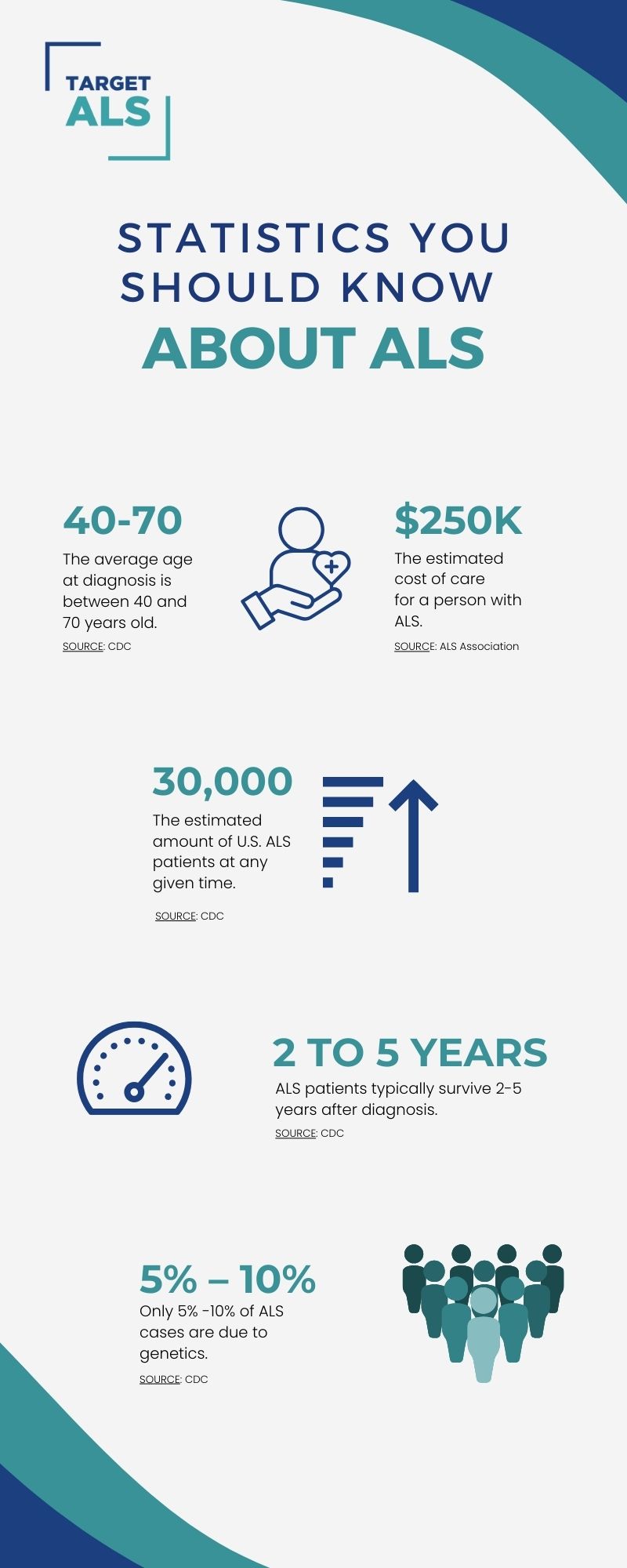
About ALS
Understanding ALS
Amyotrophic Lateral Sclerosis (ALS or Lou Gehrig’s disease) remains a life-changing disease for people living with it, their families and the communities around them.
ALS is an irreversible degenerative disease of motor neurons, which are the nerve cells in the spinal cord and brain that control muscles. We need our muscles for all movements, including to breathe, swallow, talk, and walk, among other daily activities. It is estimated that at any given time, there are about 30,000 people living with ALS in the United States.
The onset of ALS typically occurs between the ages of 40-70, although the disease can be diagnosed earlier or later. The condition can affect individuals of all races and ethnic backgrounds. In general, slightly more men than women are affected.
Understanding ALS
There is a preclinical phase of ALS, where individuals are not yet symptomatic, that can be highly variable and can last many years. The first signs of disease are also highly variable and can include fasciculations in limbs or face, painless muscle weakness, atrophy (loss of muscle bulk), spasticity, changes in speech, or progressive spasticity. As the disease progresses, the symptoms usually spread to other parts of the body.
Most people usually survive 2-5 years after diagnosis. However, the progression of ALS is highly variable, and the disease does not follow the same course for every individual with respect to site of origin and speed of progression. In some people, ALS progresses much slower (e.g. Dr. Stephen Hawking) for an unknown reason. Researchers are working hard to develop biomarker tools that can be used to predict and monitor disease progression.

Types of ALS
Approximately 90% of ALS is sporadic, meaning it arises without an inherited genetic cause or family history of the disease. 10% of ALS is familial, meaning a specific gene mutation that increases ALS risk was inherited by an individual diagnosed with ALS. Recent genetic research indicates that hereditary forms of ALS may be more common than previously believed, because additional specific genes and mutations that influence ALS risk have been discovered.
Sporadic ALS
The most common form of ALS in the United States, accounting for approximately 90% of cases. It occurs without a family history of the disease.
Familial ALS
A rarer, inherited form of ALS. However, recent genetic discoveries suggest hereditary cases may be more common than previously understood. Although ALS may run in a family, the specific gene mutation that causes a family’s diagnosis may still be unidentified.
Treatment for ALS
While there is currently no cure for ALS, there are three FDA-approved drugs available to people with ALS in the U.S. including, riluzole, Radicava, and tofersen. There are also many clinical trials ongoing to test new potential therapies (listed on CDC.gov and Healy ALS Platform Trials) and ongoing research to develop new therapeutics for people with ALS.
However, to truly make significant progress, it’s essential that we invest in a wide array of biological research, which can drive the development of multiple therapies targeting different aspects of ALS and sporadic and familial forms of the disease. This broader focus is critical, as it improves scientists’ and clinicians’ biological understanding of the disease, allowing drug development to move beyond funding a single drug and expanding the possibilities for more diverse and effective treatments.
Target ALS emphasizes this approach, knowing that the solution to ALS will not come from one single therapeutic, but from a pipeline of candidate drugs entering clinical trials. More clinical trials mean more opportunities for breakthroughs, bringing us closer to our ultimate goal and vision: a world where Everyone Lives. Continued funding is crucial to advancing this research and providing hope for those living with ALS. Every investment pushes us closer to our mission: accelerating the path to effective treatments and biomarkers for ALS.
Learn more about Target ALS’s Basic Biology Grantees
and the research that they are conducting.
What causes ALS?
The exact cause of ALS remains unknown, but several factors are believed to contribute to its development, including genetic and environmental factors. At least 40 genes that influence ALS risk have been identified with four genes that can have causal genetic mutations that run in families: C9orf72, TDP43, FUS, and SOD1. Other risk factors for ALS can include military history and certain types of sports-related injury or trauma.
While these factors are associated with the development of ALS, the interaction between genetic and environmental components is not yet fully understood. A lack of research in diverse populations and underrepresented communities also impedes progress in understanding the global incidence and cause of ALS and creates bias in research that is currently available.

Learn more about Target ALS’s Global
Natural History Study.
Understanding the Genetics Behind ALS
In most cases, ALS is a sporadic disease, meaning it occurs without a family history. However, approximately 10% of cases have a known family history.
The most common genetic cause of ALS is a mutation in the C9orf72 gene, which is responsible for nearly half of all familial ALS cases and about 10 percent of sporadic cases. This mutation is also associated with frontotemporal dementia (FTD), a condition that can co-occur with ALS and is often diagnosed in people with familial or sporadic ALS.
In over 60 percent of familial ALS cases, and up to 15 percent of sporadic cases, mutations in known ALS genes are identified, with many of these discoveries made in the past decade. Despite this progress, the genetic cause remains unknown in a significant portion of ALS families and most sporadic cases. Target ALS’s research ecosystem is actively working to uncover the gene mutations that drive ALS, either individually or in combination, to improve our understanding and treatment of the disease.

What are the symptoms of ALS?
Early symptoms of ALS include: muscle twitches in the arm, leg, shoulder, or tongue, muscle cramps, tight and stiff muscles, muscle weakness, slurred and nasal speech, and difficulty chewing or swallowing. Approximately 30% of individuals diagnosed with ALS will also experience cognitive impairment or other behavioral symptoms of FTD. As a scientific/research organization, Target ALS encourages anyone concerned about symptoms to consult their medical provider.
How is ALS diagnosed?
ALS is mainly diagnosed through a combination of observing symptoms during a physical examination, reviewing the person’s medical history, and conducting tests to exclude other conditions. Regular neurological evaluations help monitor the progression of symptoms like muscle weakness, muscle wasting, and spasticity.
There is no single diagnostic test for the disease. Instead doctors look for patterns and seek to eliminate alternatives, which means that it can take months, if not years, for an ALS diagnosis.

Support the Global ALS Research Community
Your support helps us provide essential tools to researchers around the world, ensuring that critical discoveries are within reach for all. Join us in empowering the global ALS research community and driving progress toward effective treatments. Make a difference today—every donation brings us one step closer to a world where Everyone Lives.

